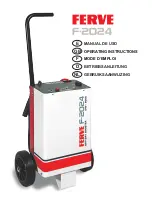
STEERING
To help prevent damage to the power
steering system:
•
Never hold the steering wheel at its
furthest turning points (until it stops)
for more than three to five seconds
when the engine is running.
•
Do not operate the vehicle with a low
hydraulic fluid level. See
•
Some noise is normal during operation.
If excessive, check for low hydraulic
fluid level before seeking service by
your dealer.
•
Heavy or uneven efforts may be caused
by low hydraulic fluid. Check for low
hydraulic fluid level before seeking
service by your dealer.
•
Do not over fill the hydraulic fluid as
this may result in leaks from the
reservoir. See
If the power steering system breaks down
(or if the engine is turned off), you can
steer the vehicle manually, but it takes
more effort.
If the steering wanders or pulls, check for:
•
an improperly inflated tire
•
uneven tire wear
•
loose or worn suspension components
•
loose or worn steering components
•
improper vehicle alignment
A high crown in the road or high crosswinds
may also make the steering seem to
wander or pull.
DRIVE MODE CONTROL
Drive Mode Selection
Your vehicle has five selectable drive
modes that deliver an enhanced driving
experience through a suite of sophisticated
electronic vehicle systems. In response to
vehicle use and driving conditions, the
selection of the drive mode optimizes
handling and powertrain response. This
provides a single location to control
multiple systems performance settings.
Using Selectable Drive Modes
E227821
To change the drive mode setting, use the
rotary switch on the left side of the steering
wheel.
Note:
To engage or disengage Track or
V-Max Drive Modes, the car must be at a
stop with the transaxle in park (P) and the
engine running. This is necessary since the
vehicle ride height will change. You can
change between Normal, Wet and Sport
Drive Modes while the vehicle is in motion.
114
Ford GT (CGX) Canada/United States of America, enUSA, First Printing
Driving Aids
















































